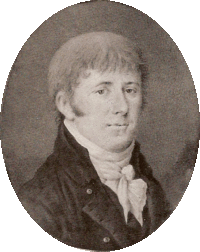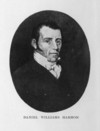
Source: Courtesy of Wikimedia Commons
MACKENZIE, RODERICK (although the name is frequently written McKenzie, he signed Mackenzie), fur trader, militia officer, office holder, jp, author, and politician; b. c. 1761 near Inverness, Scotland, eldest son of Alexander Mackenzie and Catherine —; m. c. 1788 à la façon du pays an Indian woman, and they had three children; m. 24 April 1803 Rachel Chaboillez, daughter of Charles-Jean-Baptiste Chaboillez*, and they had at least two sons and three daughters who survived infancy; d. 15 Aug. 1844 in Terrebonne, Lower Canada.
Roderick Mackenzie was the most prominent of several men of that name who were involved in the fur trade. He was a first cousin of the explorer Sir Alexander Mackenzie*, and three of his brothers, Donald*, James, and Henry*, were fur traders, as were his father-in-law, his brother-in-law Charles Chaboillez*, and his relative by marriage Simon McTavish*.
Roderick arrived in the province of Quebec in 1784 – presumably because of his ties with his cousin, since by 1785 he was employed as a clerk and Alexander’s assistant in Gregory, MacLeod and Company [see John Gregory*; Normand MacLeod*]. The firm, which had earlier concentrated on the trade in the Detroit region, had turned its attention to the northwest in the winter of 1783–84, but it could not match the resources of its well-established rival, the North West Company. Mackenzie, who was sent to Snake (Pinehouse) Lake (Sask.) for the winter of 1786–87, brought word to Grand Portage (near Grand Portage, Minn.) in the summer that the intense rivalry had led to the murder of John Ross, a wintering partner in Gregory, MacLeod. At McTavish’s invitation, Gregory, MacLeod joined the NWC later that year, ending the friction.
By 1787 Mackenzie had decided to leave the fur trade, apparently feeling that his position as clerk, which gave him no share in profits, was akin to slavery. Alexander dissuaded him and the following year Roderick joined his cousin in the Athabasca department. He was sent to establish Fort Chipewyan (Alta) at the southwestern end of Lake Athabasca and was left in charge of the fort, which became the company’s headquarters in the region, during Alexander’s absences in 1789, 1791–92, and 1792–93. From 1794 Alexander ceased to be a wintering partner and Roderick succeeded him as head of the department. The following year Roderick became a partner in the NWC. During his return from a furlough spent in the east in 1798–99, he rediscovered an old canoe route that had been used by the French; the discovery allowed the NWC to shift its trans-shipment base from Grand Portage, which had become American territory, to Kaministiquia (Thunder Bay, Ont.).
By the end of the century Roderick had spent almost 15 years in the northwest and his ultimate desire was to return to the comforts of civilization. By all accounts he was a tough and resourceful man, but he had been in the shadow of Alexander, who had a reputation for driving men hard. Yet Roderick and Alexander were close friends until 1799. Roderick was not a party to the quarrel between Alexander and McTavish which contributed to his cousin’s departure in that year from McTavish, Frobisher and Company, the dominant firm in the NWC coalition. In Roderick’s words, “The absence of Mr. MacKenzie from the concern created a vacancy and . . . application was made to me to supply his place which I accepted though with great reluctance.” The reluctance was no doubt in anticipation of Alexander’s displeasure and indeed he did not write to Roderick until 1805.
In November 1800 Roderick Mackenzie became a partner in a reorganized McTavish, Frobisher with McTavish, Gregory, William* and Duncan* McGillivray, and William Hallowell. He agreed to spend one last winter, 1800–1, in the west and then he settled in Terrebonne. After he ceased to be a wintering partner, he was required to surrender one of his two NWC shares. He gave up the other in 1805 as part of the reorganization occasioned by the NWC’s absorption of the New North West Company (sometimes called the XY Company). On 1 Dec. 1806 McTavish, Frobisher was reconstituted as McTavish, McGillivrays and Company with the McGillivrays, William Hallowell and his brother James, Angus Shaw*, and Mackenzie as partners. Mackenzie’s participation in the firm’s affairs started to wane, although he continued to attend the NWC meetings at Fort William (Thunder Bay) until 1808. By 1813 he was over 50 and he elected not to renew his place in the partnership. His one-fifteenth share was bought out by his partners for £10,000, payable in annual instalments. Perhaps as early as 1805 and at least during 1812–13 he was a partner with his brother Henry, the Hallowells, and other prominent fur traders in Mackenzie, Oldham and Company, a firm connected with the trade. He retained a financial tie with McTavish, McGillivrays and when it went bankrupt in 1825 he sued the partners, including his brother Henry, winning a judgement of £7,308 plus interest three years later. He was unable to collect and in 1832 sold his claim to Samuel Gerrard* for £6,500.
During his career Mackenzie displayed literary interests that are at odds with the usual image of a fur trader. He apparently had books sent to him on a regular basis, and according to one source he established a library for NWC employees in the Athabasca. Once settled in Terrebonne, he spent considerable energy collecting material on the fur trade, the Indians, and the natural history of the west. In 1806 he had a 60-page questionnaire prepared for distribution to fur traders. Printing delays forced him to send a one-page circular instead. Many of the materials he collected were published by his grandson-in-law Louis-François-Rodrigue Masson* in Les bourgeois de la Compagnie du Nord-Ouest. Mackenzie himself has been credited with the authorship of the history of the fur trade that appears as the introduction to his cousin’s Voyages from Montreal and of “A brief account of the fur trade to the northwest country . . . ,” published anonymously in the Canadian Review of 1824. A member of the Literary and Historical Society of Quebec and the American Antiquarian Society, he was also a fellow of the Royal Society of Northern Antiquaries at Copenhagen.
In 1814 Mackenzie purchased the seigneury of Terrebonne from the McTavish estate, agreeing to pay £8,000 plus £1,200 per year until the total, £28,000, had been attained. He planned to continue McTavish’s commercial development of the property and wrote of raising the annual revenue from £1,000 to £3,000. He never became a seigneur, however, and had to leave the property in 1824 after a court action, initiated by McTavish’s widow, cancelled his purchase because the executors had exceeded their authority in making the sale. He nevertheless continued to live in Terrebonne.
Mackenzie received a number of appointments typical of a man of his station. In 1812 he was commissioned a lieutenant-colonel in the Terrebonne militia. From 1804 to 1816 he was a justice of the peace for the Indian Territory and from 1821 to 1839 he was a justice for the districts of Montreal, Quebec, Trois-Rivières, Gaspé, and Saint-François. He was appointed a commissioner of roads and bridges for the county of Effingham in 1817 and it was probably in this capacity that two years later he promoted improvements to the Rivière des Prairies so as to facilitate the passage of timber rafts. He also served as a commissioner for the erection of free schools in Terrebonne–Effingham in 1809, and on a commission to study the best means of building a bridge between Montreal and the mainland in 1832.
Mackenzie’s most significant appointment was to the Legislative Council of Lower Canada on 10 May 1817. The appointment, which he held until March 1838, was a measure of his standing since fellow members were among the most prominent men of their time. He was very active on the council in the 1820s and was on good terms with the governor-in-chief, Lord Dalhousie [Ramsay]. His political views were representative of the opinions of the Montreal merchant community. He was an ardent supporter of the union of the Canadas proposed in 1822 and resolutely opposed to the views of the Patriote majority in the House of Assembly.
Little is known of the Indian family Mackenzie left behind in the northwest. His daughter Nancy* married fur trader John George McTavish à la façon du pays and another daughter, Louisa, married Angus Bethune*, a chief factor in the Hudson’s Bay Company. Mackenzie formally married a Roman Catholic according to Anglican rite but gave money to, and had one of his sons of the marriage baptized at, the Presbyterian St Gabriel Street Church in Montreal. Of the children born to him and his second wife, Alexander became an officer in the British army, Charles Roderick took up law, and his daughters married prominent businessmen or lawyers.
Roderick Mackenzie was a solid member of the second rank of Montreal fur traders. Always a follower rather than a leader, he chose semi-retirement after his fur-trading days rather than active participation in mercantile life. He continued to identify with and promote the interests of Montreal’s merchant community until failing health in the 1830s removed him from public life.
Roderick Mackenzie is probably the author of the introduction to Alexander Mackenzie’s Voyages from Montreal, on the river St. Laurence, through the continent of North America, to the Frozen and Pacific oceans; in the years, 1789 and 1793; with a preliminary account of the rise, progress, and present state of the fur trade of that country, [ed. William Combe] (London, 1801) and of “A brief account of the fur trade to the northwest country, carried on from Lower Canada, and of the various agreements and arrangements under which it was conducted,” Canadian Rev. and Literary and Hist. Journal (Montreal), no.1 (July 1824): 154–57.
ANQ-M, CE1-63, 24 avril 1803. McGill Univ. Libraries, Dept. of Rare Books and Special Coll., ms coll., CH21.S57, CH23.S59, CH27.S63, CH149.S19, CH171.S153, CH175.S175. PAC, MG 24, L3: 9550–58, 26406–9, 26713–20; RG 68, General index, 1651–1841. Les bourgeois de la Compagnie du Nord-Ouest (Masson). Docs. relating to NWC (Wallace). Alexander Mackenzie, The journals and letters of Sir Alexander Mackenzie, ed. W. K. Lamb (Toronto, 1970). Montreal Transcript, 20 Aug. 1844. F.-J. Audet, “Les législateurs du Bas-Canada.” P. G. Roy, Inv. concessions. Turcotte, Le Conseil législatif. Campbell, Hist. of Scotch Presbyterian Church. Henri Masson, Joseph Masson, dernier seigneur de Terrebonne, 1791–1847 (Montréal, 1972). W. S. Wallace, The pedlars from Quebec and other papers on the Nor’Westers (Toronto, 1954).
© 1988–2024 University of Toronto/Université Laval
Image Gallery

Cite This Article
Peter Deslauriers, “MACKENZIE, RODERICK,” in Dictionary of Canadian Biography, vol. 7, University of Toronto/Université Laval, 2003–, accessed April 23, 2024, http://www.biographi.ca/en/bio/mackenzie_roderick_7E.html.
The citation above shows the format for footnotes and endnotes according to the Chicago manual of style (16th edition). Information to be used in other citation formats:
| Permalink: | http://www.biographi.ca/en/bio/mackenzie_roderick_7E.html |
| Author of Article: | Peter Deslauriers |
| Title of Article: | MACKENZIE, RODERICK |
| Publication Name: | Dictionary of Canadian Biography, vol. 7 |
| Publisher: | University of Toronto/Université Laval |
| Year of publication: | 1988 |
| Year of revision: | 1988 |
| Access Date: | April 23, 2024 |













